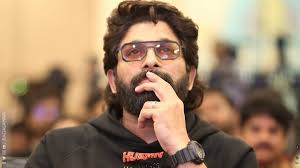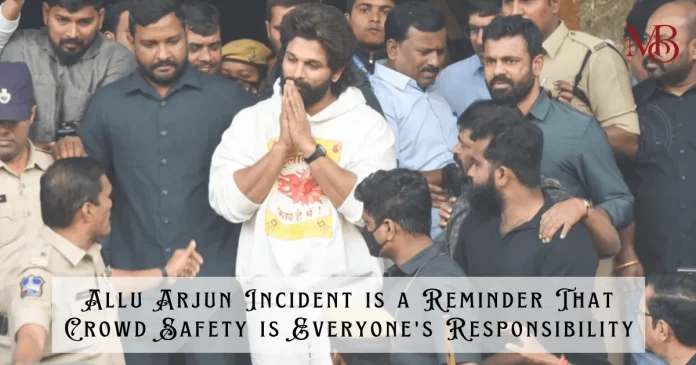India is a country where cinema is more than just entertainment; it is a way of life. Celebrities are revered, and fan frenzy often knows no bounds. However, this adulation can sometimes take a tragic turn. The recent incident involving Allu Arjun, one of India’s biggest film stars, is a stark reminder of how a lack of planning, inadequate crowd management, and public behavior can lead to devastating consequences. This blog examines the incident, the role of all stakeholders, and why crowd safety is not just the responsibility of event organizers but society as a whole.
Allu Arjun Incident: What Happened and Why?
On December 4, 2024, Allu Arjun made an unplanned visit to a Hyderabad theater hosting the premiere of his much-anticipated film Pushpa 2: The Rule. Word of his appearance spread like wildfire, drawing thousands of fans eager to catch a glimpse of their favorite star. The unannounced nature of his visit caught the theater’s management off-guard, and they were unprepared for the massive surge of the crowd.

The situation quickly spiraled out of control. With no organized crowd control measures in place, fans rushed toward the theater, creating a stampede. Tragically, a 35-year-old woman lost her life, and her 8-year-old son was critically injured. This heartbreaking incident shocked the nation, leading to widespread outrage and questions about accountability.
Following the incident, Allu Arjun, along with members of his security team and the theater management, was taken into custody. Charges of “culpable homicide not amounting to murder” were filed against them under Section 304 of the Indian Penal Code (IPC). The actor was released on bail the next day, but the incident raised important questions: Who is responsible for such tragedies, and how can they be avoided in the future?
Read more: The Allu Arjun Incident is a Reminder That Crowd Safety is Everyone’s Responsibility
Why Allu Arjun Was Blamed?
Allu Arjun’s presence at the event became the focal point of the blame for several reasons:
- Unannounced Appearance: Allu Arjun’s visit to the theater was not pre-approved or coordinated with local authorities. This lack of communication meant that adequate crowd control measures were not in place, leading to chaos.
- Influence of Stardom: In India, the presence of a superstar is enough to draw thousands of fans, many of whom are willing to disregard safety protocols. The organizers underestimated the draw of Allu Arjun’s celebrity status and failed to prepare accordingly.
- Failure to Anticipate Risks: The actor’s team, the theater management, and security personnel failed to anticipate the risks associated with a sudden appearance, particularly in a confined space like a movie theater.
- Legal and Public Perception: Under Indian law, celebrities and organizers can be held accountable for negligence if their actions, directly or indirectly, contribute to a loss of life. Public opinion also played a role, as fans and critics alike questioned the necessity of such an appearance.
Why Allu Arjun Should Not Be Solely Blamed?
While it is easy to point fingers at Allu Arjun, it is important to understand that tragedies of this scale are rarely caused by one individual. Multiple factors contributed to the stampede:
- Inadequate Management and Security: The theater management and local authorities share a significant portion of the blame. Given the actor’s massive fan following, proper security measures, barricades, and crowd control personnel should have been in place.
- Unruly Crowd Behavior: While fans’ enthusiasm is understandable, it is crucial to remember that public safety is a shared responsibility. Pushing, shoving, and rushing toward the venue escalated the chaos, making the situation unmanageable.
- Lack of Preparedness: Emergency exits, medical aid, and law enforcement presence were either insufficient or absent. Large gatherings require meticulous planning, which was lacking in this case.
- Celebrity Expectations: Stars often face immense pressure to engage with fans and promote their work. While Allu Arjun’s intentions were likely positive, the unplanned nature of the visit led to unintended consequences.
Allu Arjun Incident and Past Incidents That Serve as a Lesson
Unfortunately, stampedes and crowd-related tragedies are not uncommon in India. Several similar incidents highlight the need for better crowd management and public awareness:
- 2008 Naina Devi Temple Stampede: Over 160 people lost their lives in Himachal Pradesh when panic broke out due to rumors of a landslide.
- 2013 Allahabad Kumbh Mela Tragedy: Poor crowd management at a railway station during the religious gathering resulted in a stampede that killed 36 people.
- 2022 Vaishno Devi Temple Stampede: A lack of crowd control during New Year celebrations led to the death of 12 pilgrims and injuries to many more.
Each of these tragedies had similar causes: overcrowding, lack of preparedness, and public panic. These incidents serve as grim reminders that crowd safety must be a collective effort.
The Role of Management, Authorities, and Society
1. Management and Organizers
Event organizers and venue management bear the primary responsibility for ensuring public safety. Proper planning, coordination with law enforcement, and implementing crowd control measures such as barricades, designated entry/exit points, and medical facilities are non-negotiable.
2. Local Authorities
Authorities must anticipate risks during large gatherings and proactively deploy security personnel. The police should coordinate with event organizers to enforce safety protocols and manage crowd movement effectively.
3. Celebrities and Their Teams
Celebrities must be mindful of the impact their presence can have on fans. Any public appearance should be planned in coordination with event managers and authorities to ensure safety.
4. The Public
Perhaps the most overlooked aspect of crowd safety is public behavior. Fans must act responsibly, understanding that pushing, shoving, and ignoring safety instructions can lead to disastrous outcomes. While excitement is natural, safety should always come first.
Data on Stampedes in India
According to data from the National Crime Records Bureau (NCRB), India witnesses around 1,500 deaths annually due to stampedes, most of which occur at religious gatherings, concerts, and large events. Key statistics include:
- Religious Events: Account for nearly 70% of stampede-related deaths.
- Movie Promotions and Concerts: Contribute to around 10-15% of such incidents, often due to inadequate security measures.
- Urban vs Rural Areas: Urban areas report a higher frequency of stampedes due to denser populations and smaller event venues.
These figures highlight the urgent need for collective awareness and better event planning.
How Can Such Tragedies Be Avoided?
Preventing stampedes requires a multi-pronged approach that involves all stakeholders:
- Pre-Event Planning: Organizers must anticipate crowd size, coordinate with local authorities, and implement safety measures.
- Clear Communication: Any celebrity appearance should be announced in advance to avoid sudden crowd surges.
- Public Awareness: Fans must be educated about the importance of following safety protocols and remaining calm in crowded spaces.
- Technology and Innovation: Using drones, surveillance cameras, and crowd management software can help monitor and control large gatherings.
- Emergency Preparedness: Venues must have clear evacuation plans, medical aid, and emergency personnel on standby.
Safety is a Shared Responsibility
The tragic incident involving Allu Arjun serves as a wake-up call for everyone—celebrities, event organizers, authorities, and the public. While it is easy to blame individuals, the reality is that crowd safety requires collective responsibility.
Allu Arjun’s actions may have contributed to the chaos, but blaming him alone ignores the broader systemic issues at play. Proper planning, responsible public behavior, and proactive measures by authorities are crucial to preventing such tragedies in the future.
As fans, we must remember that excitement should never come at the cost of safety. Celebrities and organizers, on the other hand, must recognize their role in ensuring that events are both enjoyable and safe for everyone.
You might also like: Delhi’s Air Pollution Crisis 2024: When All Else Fails, Wear a Plant Around Your Neck
In the end, tragedies like these remind us that safety is not just the job of one person or one group—it is everyone’s responsibility. Follow our Odessy page for more.


